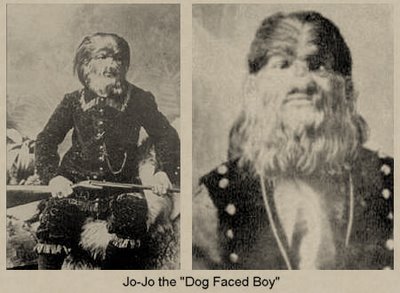The Wolf Boy, Living Dog-Faced Boy or Werewolf ave been fixtures of the sideshow world for centuries. Jo-Jo Jo the Dog-Faced Boy is perhaps the most famous of the lot, however, cases of hypertrichosis have been reported and documented long before Jo-Jo.
Hypertrichosis is really a generic term that refers to excessive hair medical. It can actually be generalized, symmetrically affecting most of the torso and limbs, or localized, affecting only a small area or location. The term is, however, usually reserved to designate the amount well above the average of normal body hair that is unwanted.
Almost all the skin of the human body – with the exception of the palms and soles of the feet – are covered with hairs or hair follicles. The density of hairs per square centimeter, the thickness of hair, hair color, the speed of hair growth and qualities as perversion tends to vary from one body part to another and as a person to another. But all in hypertrichosis various controllers for the regulation of this genetic information are faulty, damaged or nonexistent. In addition, there are some subcategories little hypertrichosis.
Congenital hypertrichosis terminalis is the change most people associate with the condition. This version includes all of the growth of body hair. Interestingly, this form of hypertrichosis is almost always associated with gingival hyperplasia – which means that these “wild men and vicious wolves teeth often very few possessions. Also people with, say the voice soft, smooth and soft. Nevoid hypertrichosis is an unusual form of hypertrichosis where a solitary circumscribed area of hair growth occurs. It is not usually associated with other diseases, unless it is presented as a faun-tail on the lower back, then it may indicate underlying spina bifida. Nevoid hypertrichosis can occur at birth or develop later in life and symptoms can range from hairy tufted ears, tails, a heavy unibrow or excessive beard in women and men as well. Finally, congenital hypertrichosis lanuginosa is a very rare form of hypertrichosis with only about 50 cases reported worldwide since the Middle Ages.
The condition is characterized by excessive growth of hair on a child at birth. Most of the body is covered with lanugo hair, which is fine hair, soft and silky that covers the fetus and is typically removed about 8 months of gestation and replaced with fine down. In this condition, the hair continues to grow throughout life. The initial shock of an infant fur covered, however, is fortunately very rare.
The exact cause of hypertrichosis is unknown. But it is to believe in a genetic disorder that is inherited or occurs as a result of a spontaneous mutation.

